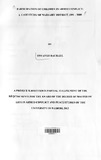| dc.description.abstract | Armed conflict has changed since the end of the Cold War 'with present conflicts predominantly taking the lives of civilians, especially children. This study examines the role and impact of armed conflict in children in Marsabit district, 1991 - 2005. The study aimed to test the hypotheses that children have been involved in the Marsabit conflicts and that they had direct and indirect impacts on children. It utilized both primary and secondary data. It draws from the works of various authors whose content is on or relates to children and armed conflict in Marsabit District. Secondary data was collected through a thorough review of books, articles, journals as well and internet sources. Primary data was collected through interview, focus group discussion and observation and was used to fill in the gaps noted from the secondary sources. Data collected was analyzed and presented qualitatively through narrative and discussions.
The study begins with a detailed the history of the conflict in the district in three phases, pre-colonial, colonial and post-colonial. Conflict in Marsabit in the precolonial era was synonymous with those that occurred in the whole of northern Kenya where communal invasions and inter-group raiding was more of a cultural phenomenon. During the colonial periods, the conflict was linked to the violence that accompanied state formation in the colonial era. In post-colonial era, conflicts in Marsabit were characterized by commercialization of cattle raiding, increased access to arms and poverty. Other proximate causes were political instigation, insecurity, revenge and intense inter-clan rivalry.
The study found out that children involvement and participation in armed conflicts was through forceful recruitment and voluntary enlisting (whether by choice or as a result of excruciating circumstance that left them no choice). The roles they played in these conflicts were both as direct combatants as well as supporting conflict process e.g. being the porters and spies. In general conflict has negatively affected the lives of children socially, physically and psychologically. Many of them died, or suffered injuries. They faced disruption in their daily lives with many being separated from their families and ended up displaced, interruption in their education hence reduced school enrollment, gender based violence as well as trauma. | en_US |

